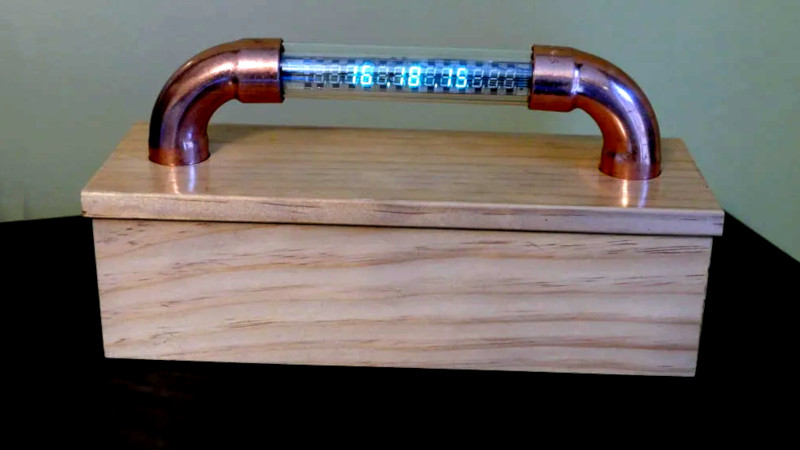There are a great many display technologies available if you wish to make a digital clock. Many hackers seem to have a penchant for the glowier fare from the Eastern side of the Berlin Wall. [ChristineNZ] is one such hacker, and managed to secure some proper Soviet kit for an alarm clock build.
The clock employs an IV-27M vacuum fluorescent display, manufactured in the now-defunct USSR. Featuring 13 seven-segment digits, it’s got that charming blue glow that you just don’t get with other technologies. A MAX6921AWI chip is used to drive the VFD, and an Arduino Mega is the brains of the operation. There’s also an HD44780-compliant LCD that can display further alphanumeric information, and a 4×4 keypad for controlling the device.
The best part of the build though is the enclosure. The VFD is encased in a glass tube, and supported at either end by 90-degree copper pipe couplers. These hold the VFD aloft, and also act as a conduit for the wires coming off each end of the tube. It’s all built on top of a wooden base that holds the rest of the electronics.
It’s an attractive build, and we love the floating look created by the glass tube construction. It’s not the first time we’ve seen old Russian VFDs, and we doubt it will be the last. Video after the break.
Th
















Very nice build, but a shame with DC filament drive. It really needs AC drive to look good.
Awesome clock!!
I am not going to lie, my first thought upon reading the title was “What the hell is a variable frequency drive doing in an alarm clock?”
CHALLENGE ACCEPTED!
For me it is the opposite. When i hear something using VFD and mistake for Vacuum Fluorescent Displays.
Blue VFDs seem to be extinct on eBay (all are green or unspecified). Anyone have a source?
As far as I know they all seem to be that bluish green color (more shifted to green, at least all the ones I’ve ordered of varying types over the years) and depending on lighting conditions, camera settings, etc it either looks blue or green in pictures. Now there are blue phosphor vfds but they seem to be modern (used as VU displays or for home entertainment systems) or have a gel filter to shift the color.
They are all the same color. I have a metric shit ton of VFD’s, from old russian, new and used to modern graphical. They all have the same color. You can filter VFD color-wise from deep blue to yellow, red, orange, green, white-ish etc.
VFD’s are a bit confusing in capturing on film/photo. Photo’s like the one above show them as being bright Blue. But in reality the IV-27M (and pretty much all VFD entries of the IV series) are very much the widespread Sea-Green colour.
Turns out Cameras are very prone to see them as being very Blue. Seeing them differently to how the appear in reality. If you see a VFD photograph with the display looking Blue there is a fair change. Especially with the older ones as real Blue VFD came far later.